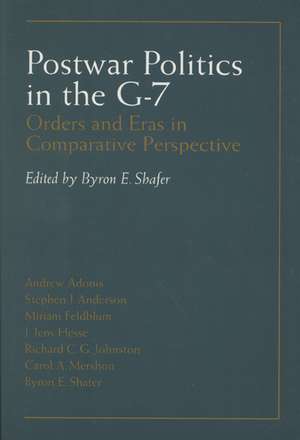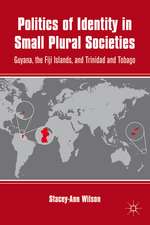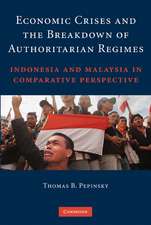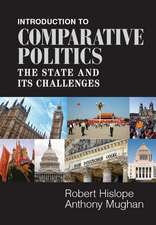Postwar Politics In The G-7: Orders And Eras In Comparative Perspective
Autor Byron E. Shaferen Limba Engleză Paperback – 14 aug 1996
This concise, comparative history looks at politics in the nations collectively known as the Group of Seven—the United States, Canada, Britain, France, Germany, Japan, and Italy—from the end of the Second World War to the end of the Cold War. Emphasizing political eras and political orders, editor Byron E. Shafer and the contributing authors use an identical framework for each nation as they consider its political evolution and the structures that shaped it. No other book offers this comparative reach or this common framework, making Postwar Politics in the G-7 useful for both students and sophisticated observers of international politics.
Postwar Politics in the G-7 provides a condensed introduction to the politics of each of the seven nations, focusing on the main political events of the last fifty years and the factors that shaped the ways each country handled those events. By presenting these accounts in a precisely parallel fashion, this volume highlights similarities and differences among the nations. Concluding chapters reassemble these comparisons for all seven of the nations together. Among the most interesting findings are the rise of an activist politics, the continuing influential role of electoral systems, and the presence of divided governance nearly everywhere. Such a carefully constructed interpretation of postwar politics highlights potentially critical elements and provides comparative insights that are essential for understanding the Group of Seven nations.
Postwar Politics in the G-7 provides a condensed introduction to the politics of each of the seven nations, focusing on the main political events of the last fifty years and the factors that shaped the ways each country handled those events. By presenting these accounts in a precisely parallel fashion, this volume highlights similarities and differences among the nations. Concluding chapters reassemble these comparisons for all seven of the nations together. Among the most interesting findings are the rise of an activist politics, the continuing influential role of electoral systems, and the presence of divided governance nearly everywhere. Such a carefully constructed interpretation of postwar politics highlights potentially critical elements and provides comparative insights that are essential for understanding the Group of Seven nations.
Preț: 137.19 lei
Nou
Puncte Express: 206
Preț estimativ în valută:
26.25€ • 28.51$ • 22.05£
26.25€ • 28.51$ • 22.05£
Carte tipărită la comandă
Livrare economică 23 aprilie-07 mai
Preluare comenzi: 021 569.72.76
Specificații
ISBN-13: 9780299151041
ISBN-10: 0299151042
Pagini: 360
Dimensiuni: 152 x 229 x 18 mm
Greutate: 0.46 kg
Ediția:New.
Editura: University of Wisconsin Press
Colecția University of Wisconsin Press
ISBN-10: 0299151042
Pagini: 360
Dimensiuni: 152 x 229 x 18 mm
Greutate: 0.46 kg
Ediția:New.
Editura: University of Wisconsin Press
Colecția University of Wisconsin Press
Recenzii
“Postwar Politics in the G-7 differs from most other professedly comparative politics books, whose several authors of separate national chapters usually analyze along their own separate lines. . . . The editor and his six co-authors have put their seven-nation study in a genuinely common intellectual framework.”—Leon D. Epstein, author of Political Parties in Western Democracies
Notă biografică
Byron E. Shafer is the Andrew W. Mellon Professor of American Government at Oxford University. He is the editor of The End of Realignment? Interpreting American Electoral Eras, also published by the University of Wisconsin Press, and of Is America Different? A New Look at American Exceptionalism and the author of Quiet Revolution: The Struggle for the Democratic Party and the Shaping of Post-Reform Politics; Bifurcated Politics: Evolution and Reform in the National Party Convention; and (with William Clagett) The Two Majorities: The Issue Context of Modern American Politics.
Descriere
This concise, comparative history looks at politics in the nations collectively known as the Group of Seven—the United States, Canada, Britain, France, Germany, Japan, and Italy—from the end of the Second World War to the end of the Cold War. Emphasizing political eras and political orders, editor Byron E. Shafer and the contributing authors use an identical framework for each nation as they consider its political evolution and the structures that shaped it. No other book offers this comparative reach or this common framework, making Postwar Politics in the G-7 useful for both students and sophisticated observers of international politics.
Postwar Politics in the G-7 provides a condensed introduction to the politics of each of the seven nations, focusing on the main political events of the last fifty years and the factors that shaped the ways each country handled those events. By presenting these accounts in a precisely parallel fashion, this volume highlights similarities and differences among the nations. Concluding chapters reassemble these comparisons for all seven of the nations together. Among the most interesting findings are the rise of an activist politics, the continuing influential role of electoral systems, and the presence of divided governance nearly everywhere. Such a carefully constructed interpretation of postwar politics highlights potentially critical elements and provides comparative insights that are essential for understanding the Group of Seven nations.
Postwar Politics in the G-7 provides a condensed introduction to the politics of each of the seven nations, focusing on the main political events of the last fifty years and the factors that shaped the ways each country handled those events. By presenting these accounts in a precisely parallel fashion, this volume highlights similarities and differences among the nations. Concluding chapters reassemble these comparisons for all seven of the nations together. Among the most interesting findings are the rise of an activist politics, the continuing influential role of electoral systems, and the presence of divided governance nearly everywhere. Such a carefully constructed interpretation of postwar politics highlights potentially critical elements and provides comparative insights that are essential for understanding the Group of Seven nations.















